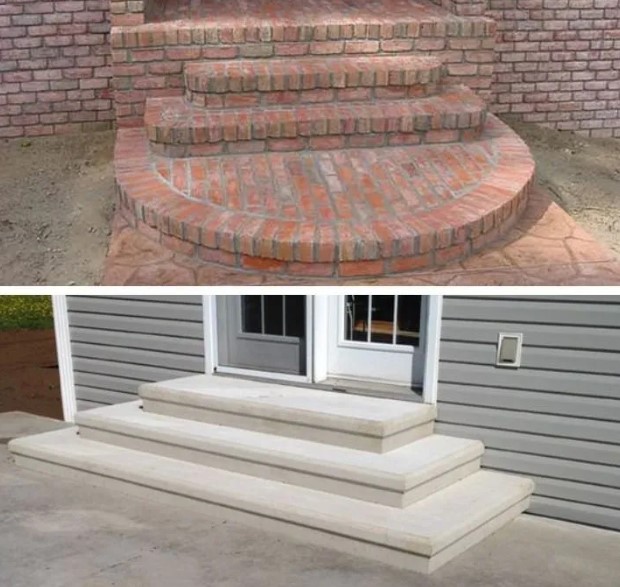When its time to replace the steps at your front entryway, you will want to choose a material that provides durability, aesthetic appeal, and the right fit for your budget. Two popular options are concrete steps and brick steps. Each material has its pros and cons to consider like cost, installation process, maintenance requirements. By understanding the key differences between concrete and brick steps, you will be able to make the choice that best suits your needs.

Concrete steps offer a lot of flexibility at an affordable price point. You can mold concrete into various shapes and designs or apply decorative stamping. This allows concrete steps to complement different architectural styles.
Concrete is also a durable material that can withstand weathering over many years. However, concrete does require some ongoing upkeep as cracks can form with frost, and it may stain more easily than other materials. Sealing is usually needed to protect the concrete’s appearance.
Brick steps offer a timeless look that will enhance the appearance of any home. They provide longevity for generations with little maintenance required once installed properly.
Concrete steps are low-cost due to easy precasting, mixing, and install. Brick steps require pricey skills like mortaring, precise stone cutting, and specialized masonry work.
Over time, maintenance costs can change. Concrete may develop cracks or require repair, raising long-term costs. Brick typically needs only occasional cleaning since damaged bricks are cheaply replaced individually.
Concrete allows for more modern designs through stamping, carving, and custom forming. However, nothing matches the classic, traditional charm of a brick staircase.
While concrete dyeing and stamping creates various color/texture options, brick offers a naturally beautiful range of hues from reds and oranges to blues and grays.
While a concrete project can be handled by a general contractor, brick ideally requires a skilled mason. Hiring a professional ensures the staircase is properly installed according to code and manufacturer requirements.
Both benefit from routine sweeping, but concrete may require occasional sealing or waterproofing, whereas brick cleaner or a light power washing usually suffices.
Small concrete cracks require patching compounds while loose bricks can simply pop out and be replaced individually on brick staircases.
When new, both have adequate grip levels. Over time, concrete may become smoother, whereas brick maintains a textured surface.
Both materials can provide safe, durable staircases as long as they are properly installed on an adequate base with routine visual inspections.
For over 15 years, Atlantic Brick and Stone has completed countless concrete, brick, and stone works with unparalleled quality and attention to detail. Whether you need a small entryway installed or a large commercial concrete steps, we have the expertise and experience to handle any job flawlessly. Contact us for a free estimate!
Both concrete and brick steps deliver attractive, rugged entryways when installed by professionals. But preferences for curb appeal, budget, and long-term care should sway the decision.
Options include stamping/molding, adding a border, dyeing/staining, and using sealants and outdoor carpeting for traction.
There is no single better choice – it depends on budget, installation complexity, maintenance preferences, and desired aesthetic.
Brick steps can last indefinitely with proper installation. Repairs may be needed every 20+ years depending on environment and usage.
GET STARTED
Create stunning structures with our residential and commercial masonry services in Fredericton. From meticulous designs to the completed build, our process is professional and rewarding, and we can’t wait to build your dream with you.
Atlantic Brick and Stone, one of the best masonry contractors in Fredericton, NB
Contact
8 Muskie Street, Lower Kingsclear, New Brunswick E3E 0E7, Canada